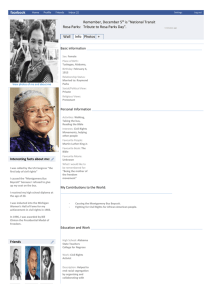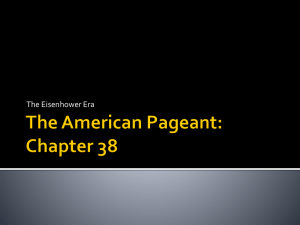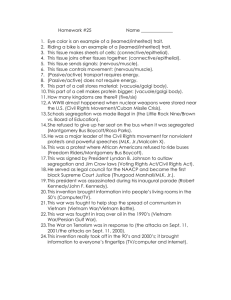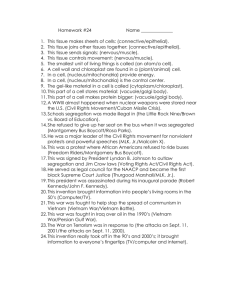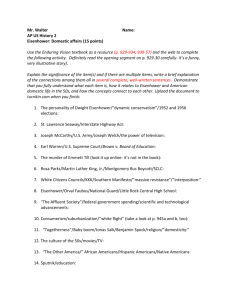Civil Rights
advertisement
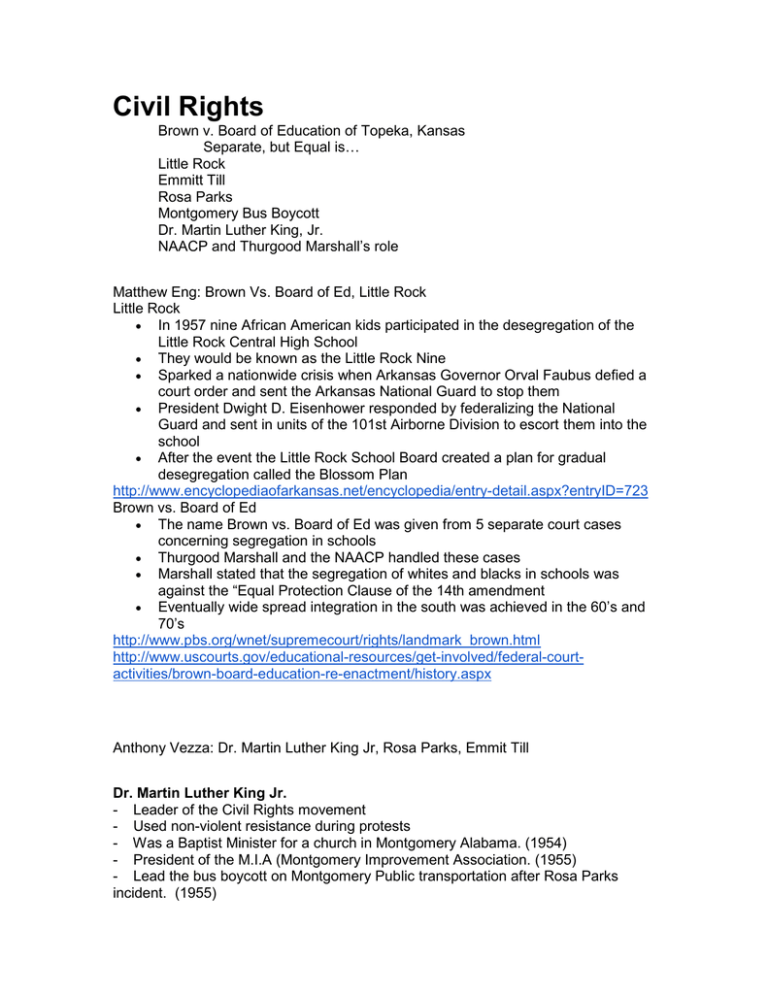
Civil Rights Brown v. Board of Education of Topeka, Kansas Separate, but Equal is… Little Rock Emmitt Till Rosa Parks Montgomery Bus Boycott Dr. Martin Luther King, Jr. NAACP and Thurgood Marshall’s role Matthew Eng: Brown Vs. Board of Ed, Little Rock Little Rock In 1957 nine African American kids participated in the desegregation of the Little Rock Central High School They would be known as the Little Rock Nine Sparked a nationwide crisis when Arkansas Governor Orval Faubus defied a court order and sent the Arkansas National Guard to stop them President Dwight D. Eisenhower responded by federalizing the National Guard and sent in units of the 101st Airborne Division to escort them into the school After the event the Little Rock School Board created a plan for gradual desegregation called the Blossom Plan http://www.encyclopediaofarkansas.net/encyclopedia/entry-detail.aspx?entryID=723 Brown vs. Board of Ed The name Brown vs. Board of Ed was given from 5 separate court cases concerning segregation in schools Thurgood Marshall and the NAACP handled these cases Marshall stated that the segregation of whites and blacks in schools was against the “Equal Protection Clause of the 14th amendment Eventually wide spread integration in the south was achieved in the 60’s and 70’s http://www.pbs.org/wnet/supremecourt/rights/landmark_brown.html http://www.uscourts.gov/educational-resources/get-involved/federal-courtactivities/brown-board-education-re-enactment/history.aspx Anthony Vezza: Dr. Martin Luther King Jr, Rosa Parks, Emmit Till Dr. Martin Luther King Jr. - Leader of the Civil Rights movement - Used non-violent resistance during protests - Was a Baptist Minister for a church in Montgomery Alabama. (1954) - President of the M.I.A (Montgomery Improvement Association. (1955) - Lead the bus boycott on Montgomery Public transportation after Rosa Parks incident. (1955) - Became civil rights leader after the bus boycott. (1956) - Becomes president of Christian Leadership Conference (1960) - “I Have a Dream” speech gave on August 28 , 1963. It was held at the Lincoln Memorial where more than 250,000 people watched the speech. - Was there when Lyndon B. Johnson when he signed the Civil Rights Act of 1964. - Won Nobel Peace Prize (1964) - Assassinated in Memphis, Tennessee, by James Earl Ray. Rosa Parks - On December 1 1955, Rosa Parks refused to get up out of her seat so a white person could sit in her seat. - The bus driver had her arrested for her actions. - The Civil Rights movement launched a boycott on the Montgomery buses. (The bus company that the bus belonged to that Rosa Parks was on) - The segregation on buses eventually became unconstitutional. - Rosa Park’s acts defeated the racist system making her known as “the mother of the civil rights movement.” Emmit Till - Emmit Tilll was a young African American boy who was living in Money, Mississppi with his Great Uncle for the summer of 1955. - He was kidnapped by Roy Bryant and J.W Milam who brutally beated him and shot him the head. This was over Emmet whistling at Carolyn Bryant (Roy’s wife) - They were both arrested on kidnapping charges. - Police eventually found the body in the Tallahatchie River. - The jury during the trial of both men acquitted the charges. th st http://www.infoplease.com/spot/bhmheroes1.html http://www.pbs.org/wgbh/amex/till/timeline/timeline2.html http://www.cnn.com/2013/01/17/us/martin-luther-king-jr-fast-facts/ Harry O: NAACP, Thurgood Marshall’s role, Bus Boycott NAACP stand for the National Association for the Advancement of Colored People and they fight for the civil rights of colored people The Montgomery Bus Boycott consisted of angry bus drivers who went on strike after the city authorities refused to arrest T.J. Jemison. It ended when the mayor decided to only reserve the first 2 rows for whites and the last 2 rows for blacks. Blacks had to pay at the front of the bus and enter through the back of the bus. Thurgood Marshall’s role in Script for Imovie: Ever since the late 1800’s African Americans have been fighting for civil rights and equality till the 1970’s. During the 1950’s the Civil Right movement really took a stand against segregation One of the first event during the mid 1950’s really sparked the movement was the Rosa Parks incident - On December 1 1955, Rosa Parks refused to get up out of her seat so a white person could sit in her seat. - The bus driver had her arrested for her actions. - The Civil Rights movement launched a boycott on the Montgomery buses. (The bus company that the bus belonged to that Rosa Parks was on) - The leader of the boycott on the Montgomery buses was the Civil Rights leader, Dr. Martin Luther King Jr. st Dr. Martin Luther King Jr. - Was a Baptist Minister for a church in Montgomery Alabama - He used non-violent resistance during protests - His “I Have a Dream” speech was given on August 28 , 1963. It was held at the Lincoln Memorial where more than 250,000 people watched the speech. - The NAACP awarded King with the Spinguard Metal th NAACP - NAACP stand for the National Association for the Advancement of Colored People who fought for the civil rights of colored people - They assisted Thurgood Marshal in court cases to African Americans in court One of the most well known they worked on was Brown vs. Board of Education The name Brown vs. Board of Ed was given from 5 separate court cases concerning segregation in schools It was stated that the segregation of whites and blacks in schools was against the “Equal Protection Clause of the 14th amendment Eventually wide spread integration in the south was achieved in the 60’s and 70’s One school incident in particular sparked media attention in the town of Little Rock Arkansas In 1957 nine African American kids participated in the desegregation of the Little Rock Central High School They would be known as the Little Rock Nine Sparked a nationwide crisis when Arkansas Governor Orval Faubus defied a court order and sent the Arkansas National Guard to stop them President Dwight D. Eisenhower responded by federalizing the National Guard and sent in units of the 101st Airborne Division to escort them into the school After the event the Little Rock School Board created a plan for gradual desegregation called the Blossom Plan However not all the cases were justified - In 1955 a African American boy named Emmett Till lived with his Uncle in Money, Mississippi. - He was kidnapped by Roy Bryant and J.W Milam who brutally beat him and shot him in the head for hitting on his wife, Carolyn Bryant - They were both arrested on kidnapping charges. - Police eventually found the body in the Tallahatchie River. - The jury during the trial of both men acquitted the charges. Overall the 1950’s was a threshold for many important Civil Rights movement victories in the later decade Politics Dwight Eisenhower (Hint-how does it relate to Civil Rights?) Eisenhower served in WWI as a lieutenant, then in WWII as commander of allied forces in Europe, where he was an essential part of the liberation of Europe. Afterwards, he became Military Governor in Germany and Army Chief of Staff, then Nato Supreme Commander, then, in 1952, became President of the U.S. Was pres from jan 20 1953- jan 20 1961...34th president Eisenhower and the civil right acts: Eisenhower backed the Civil Rights Act of 1957 and the Civil Rights Act of 1960. The former created a permanent Civil Rights Commission, as well as a Civil Rights Division within the Justice Department aimed at combating efforts to deny blacks the vote. The latter granted the federal courts the authority to register black voters. Eisenhower- When Eisenhower (a Republican) was elected as President, people waited for him to condemn McCarthy. Eisenhower's response, “don't get in a pissing match with a skunk.” General Dwight D. Eisenhower was the commander of the NATO forces. 1952 Election-Eisenhower runs and says, “I will go to Korea.” Richard Nixon- Republican Vice Presidents during his presidency: Gerald Ford, Spiro Agnew 37th Pres of the U.S. First elected to presidency in 1968. Served from 1969 to 1974 Starting with Pres Lyndon Johnsons decision not to run a second time, the campaign of that year reflected the uncertainty and turmoil that gripped much of the nation -In the Spring, Martin Leuther King Jr. was assassinated in Memphis -In June, Senator Robert Kennedy was shot and killed after his victory in the California democratic primary -Nixons eventual opponent was Hubert Humphrey -After the dust settled, Richard Nixon was the last contender standing -By the time Richord Nixon stepped in front of a television, he faced a divided nation: War raged in Vietnam, and American soldiers were dying...people predicted that the activists would not stop until they brought the president down -Nixon created a policy of gradual withdrawal from Vietnam, which was supported -Nixon presented his address to the people on national television. In it he outlined the situation with Vietnam -Nixon became a national celebrity because of the case, but liberal commentators scorned him. -Nixons retirement lasted 6 years. · Eisenhower and Nixon as President and Vice-President (what did they accomplish?) -Nixon’s first major clash with the press was when he ran as Dwight D. Eisenhower’s vice presidential running mate. To avoid being dumped my Eisenhower, Nixon turned the media against itself on nation-wide television. Extra: Truman creates the fair deal to replace the new deal and start the fight for civil rights..which was Truman’s plan to combat the Republican Congress’ weakening of the New Deal. (1953) The beginning of our involvement in Vietnam After Ho Chi Minh founded the democratic republic of Vietnam in 1945, the United States pledged $15 million worth of military aid to France to help them fight in Vietnam. In 1954, the French suffer a decisive defeat at the Battle of Dien Bien Phu, and the Geneva Accords creates a cease-fire for the peaceful withdrawal of the French from Vietnam and provided a temporary boundary between North and South Vietnam at the 17th parallel. The next year, South Vietnam declared itself the Republic of Vietnam, with newly elected Ngo Dinh Diem as president. Kefauver Committee (and Organized Crime) In May 1950, at the very moment that Senator Joseph McCarthy was beginning his crusade against communist subversion, the U.S. Senate created a special committee to investigate another "enemy within": organized crime.While failing to produce effective crime-fighting legislation The Kefauver Committee lead the Special Rackets Squad of the FBI to launch 46,000 investigations and help defeat proposals to legalize gambling in Arizona, California, Massachusetts, and Montana. Elections of 1952 (Checkers Speech) and 1956 -Nixons address of September 23, 1952 -A textbook exercise in manipulation -Nixon delivered an overwrought accounting for his personal finances. The whole thing was very dramatic. -He explained that his wife did not have a decent coat, only one of a “respectable Republican cloth coat” -He said that one gift he had received was a cocker spaniel named Checkers, whom his children loved. “Regardless of what they say about it” Nixon said “We’re going to keep him.” -This was viewed by over 60 million people, the largest television audience ever. Pro-Nixon telegrams barraged Eisenhower, and the two Republicans triumphed in November. Nixon's next major television appearance did not bring such positive results. The Space Race During the Cold war, The US and Soviets Fought for supremacy in spaceflight capability. Starting when both sides began building rockets capable of taking objects into space. Works Cited: http://www.pbs.org/wgbh/americanexperience/features/general-article/nixon-politics/Nixon’s Presidency and Checkers speech http://airandspace.si.edu/exhibitions/space-race/ -Space Race http://www.digitalhistory.uh.edu/disp_textbook.cfm?smtID=2&psid=3421 -Kefauver Committee Technological Advances Inventions to make life easier Fill in the invention that goes with the year and write one fact 1950: 1951: super glue: 1951: power steering: 1952: bar code: 1954: solar battery: 1954: polypropylene: 1956: ___________________________________________________________________ _________ New Technology What year did Charles Ginsburg invent the video tape recorder? What is a transistor radio? Why was a black box so useful? What did the solar cell do? Alexander Graham Bell invented the _____________ Computer Modems were used to communicate data over the public switched telephone network. The first commercial modem was manufactured by ______________ Who were the two people that invented the integrated circuit? 1st light laser invented by Gordon Gould Copy Machine makes paper copies of documents and other visual images ____________and __________. Used in business, education, and government. ___________________________________________________________________ _________ The Dawn Of The Space Race What was the key objective of starting the space race in the United States. What was America trying to prove? (List three examples) On October 4th, 1957, what world power had the first artificial satellite that was man-made object to be placed into Earth`s orbit, and what was the satellites name? What was the name of the Soviets space probes name that landed on the moon? On May 5th, who was the first astronaut in America to go into space, but not into orbit? On January 31st, 1958, what was the name of America`s satellite that had completely changed the tides of the space race? 1.) 2.) 3.) Who technically “won” the space race? Was it the Soviet Union or the United States of America, state your reason why they won the space race first. ___________________________________________________________________ _________ Medical Advances (Polio Scare/Vaccines/DNA) The first cardiac pacemaker is developed to control irregular heartbeat. o By who? ___________ What year? _________ DNA molecule structure is studied and described. o By who? ___________ What year? _________ The first kidney transplant is performed upon two twins. o By who? ___________ What year? _________ The first artificial heart is implanted in a dog. o By who? ___________ What year? _________ Describe polio Describe Jonas Salk’s way of killing the polio virus Why was Salk’s vaccination unsuccessful? Albert Sabin o What did he do regarding the polio epidemic? ___________________________________________________________________ _________ Developments in transportation Congress passes the Federal-Aid Highway Act o What did President Eisenhower authorize when signing the FederalAid Highway Act? How did engineers design the roadways? Airports expand o People are able to get where they want to go when they want to go ___________________________________________________________________ ___
